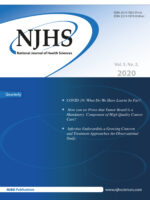COVID-19: What Do We Have Learnt So Far?
Samreen Kulsoom Zaidi
Coronaviruses (CoVs) are the largest group of viruses; order is Nidovirales while family is Coronaviridae. They are further subdivided into four groups, the alpha, beta, gamma and delta coronaviruses [1]. These viruses usually cause mild infections but two zoonotic epidemics of the betacoronaviruses, severe acute respiratory syndrome coronavirus (SARS-CoV) [2] and Middle East respiratory syndrome coronavirus (MERS-CoV) [3] have occurred in this century, mortality rates of 10% for SARS-CoV [4] while a very high i.e. 37% for MERS-CoV [5].
Received: February 18, 2020
Revised: July 07, 2020
Accepted: July 10, 2020
doi.org/10.21089/njhs.52.0055
How can we Prove that Tumor Board is a Mandatory Component of High Quality Cancer Care?
Ahmed Nadeem Abbasi, Sehrish Abrar and Benazir Mir Khan
Before embarking upon the first modality of cancer management, it is advisable to thoughrouly discuss the patients case in a site specific multidisciplinary tumor board meeting. These meetings are a necessary requirement for a high quality comprehensive cancer service. Published evidence reveals a positive relationship in the form of treatment outcomes. The outcomes are being measured in terms ofs of survival and local control of malignancies for patients who were discussed and deliberated nary tumour boards [1, 2]. These boards are vitally essential for the services offered in Low and Middle Income countries as we regard them as the lifeline for our cancer patients [3].
Received: June 17, 2020
Revised: September 11, 2020
Accepted: September 16, 2020
doi.org/10.21089/njhs.52.0058
The Effects of Osteoarthritis on Quality of Life (QoL)
Qaim Ali, Maheen Aftab and Sara Arshad
Abstract: Objective: Functionality and quality of life in patients with osteoarthritis undergoing total arthroplasty of the knee.
Materials and Methods: This study was conducted in Ziauddin hospital, Karachi from April 2018 until August 2018, making up 40 individuals who have osteoarthrosis of the knee with an indication for total arthroplasty and not being carriers of any other disease affecting the limbs lower. Two scales of evaluation were applied at two different times: pre and postoperative. Health status questionnaire (SF-36) and Knee injury and osteoarthritis outcome score (KOOS) was applied and answered in the preoperative period (on the day of surgery) and the sixth postoperative week.
Received: April 02, 2020
Revised: August 13, 2020
Accepted: August 17, 2020
doi.org/10.21089/njhs.52.0060
Infective Endocarditis: A Growing Concern and Treatment Approaches: An Observational Study
Muhammad Daoud Butt, Muhammad Sarfraz Nawaz, Basit Ramazan, Tooba Malik and Sidra Sulehri
Abstract: Objective: To determine the frequency of prevailing microorganism, treatment approach, different treatment complexities and rationalize the approach for treating Infective Endocarditis (IE) patient.
Material and Methods: The retrospective study was conducted from 01st January 2015 to 31st October 2019. Data was collected and after applying exclusion criterion 40 patients were selected and their available record was evaluated. To obtain the conclusive results, frequency and percentages were calculated.
Received: April 10, 2020
Revised: June 01, 2020
Accepted: July 27, 2020
doi.org/10.21089/njhs.52.0066
A Comparative Study: Knowledge and Practices amongst Post-Operative Patients Regarding Hospital Acquired Infections (HAI) between Private and Public Tertiary Care Setup in Pakistan
Asna Shahab, Tahir Sultan Shamsi, Erum Afaq, Omer Mustafa, Daania Aman Omer Khan, Arisha Zaheer, Safi Shaikh, Rabiya Irfan, Mustafa Saleem and Shayan Marsiya
Abstract: Background: Hospital Acquired Infection (HAI) is a major global safety concern for the health system as it increases mortality, morbidity, and length of hospital stay and contributes to the economic burden. These infections are prevalent in hospitals of developing countries such as Pakistan, due to limited resources, unsafe infection control practices and under reporting. However, post-operative patients are more prone to these infections due to immunocompromised state, antibiotic resistance, and most importantly lack of awareness regarding HAIs and their respective preventive measures. Therefore, the objective of this study was to highlight some of the serious but avoidable aspects of this largely ignored but important issue of HAIs in public and private tertiary care hospitals by assessing and comparing the need of knowledge and awareness in post-operative patients to minimize risks which in turn will decrease incidence, morbidity and mortality.
Received: April 24, 2020
Revised: May 28, 2020
Accepted: May 29, 2020
doi.org/10.21089/njhs.52.0071
Acute Leukemia of Ambiguous Lineage with a Rare Abnormality Del17p by FISH Analysis
Naeem Abbas, Samra Waheed, Aisha Jamal, Ali Saleem and Tahir Sultan Shamsi
Abstract: The World Health Organization (WHO) has categorized acute undifferentiated leukemia (AUL) as a rare subtype of acute leukemia of ambiguous lineage (ALAL). The prognosis of AUL is considered poor and it expresses no known lineage-specific markers. In majority of the cases, AUL has been associated with karyotypic abnormalities, most commonly deletion 5q and complex karyotype. Deletion 17p correlation with acute myeloid leukemia and myelodysplastic syndome has been previously established and is associated with poorer outcomes. Herein we are reporting a case of forty years old male who was referred to National institute of blood diseases and bone marrow transplantation with complains of fever, multiple neck swellings, and early satiety and was diagnosed as Acute Undifferentiated Leukemia along with deletion 17p. This is a rare entity and can aid in further diagnostic and therapeutic approaches.
Received: March 10, 2020
Revised: July 10, 2020
Accepted: July 27, 2020
doi.org/10.21089/njhs.52.0079
Acute Promyelocytic Leukemia in Pediatric Population: A Rare Presentation
Rabiah Asghar, Javera Tariq, Shahzad Ali Jiskani, Sundas Ali and Aneela Zafar
Abstract: Acute Promyelocytic Leukemia (APL) is a very uncommon type of acute myeloid leukemiacomprising less than 10% of pediatric population. Acute Promyelocytic leukemia is a neoplastic proliferation of abnormal promyelocytes in bone marrow, caused by cytogenetic abnormality t(15;17). Majority of patients (80%) have long term survival, and death occurs in approximately 10% of patients in early course of the disease; mainly because of hemorrhage. Hemorrhagic complications can be reduced by appropriate therapy if started timely, which ultimately reduces the risk of death. We report a case of 7 years old boy with complaints of fever off and on for past 06 months, bruises and swelling on left leg for 1 week, blood containing vomiting for 1day. He was diagnosed as APL on bone marrow biopsy.
Received: July 04, 2020
Revised: August 08, 2020
Accepted: August 10, 2020
doi.org/10.21089/njhs.52.0083
Rare Transformation of Chronic Myeloid Leukemia into Acute Lymphoblastic Leukemia in a 14-Year Old Patient
Javera Tariq, Sundas Ali, Shahzad Ali Jiskani and Rabiah Asghar
Abstract: Chronic myeloid leukemia is a myeloproliferative neoplasm. It is a common disease of elderly, rarely affecting pediatric, adolescent or young adults. The median age of presentation is 65 years. The incidence is 1_2 cases per 100,000 adults. Tyrosine kinase inhibitors (TKIs) are highly successful and have good remission rates in the CML treatment; though multiple factors are associated with failure of treatment. We present a patient of 14 years old male who was diagnosed as CML. He was seven months into TKI therapy, transformed into B-Lineage acute lymphoblastic leukemia.
Received: July 04, 2020
Revised: August 12, 2020
Accepted: August 13, 2020
doi.org/10.21089/njhs.52.0086
Case-Fatality Rates for COVID-19: Are we Ignoring Something?
Usama Waqar, Shaheer Ahmed, Daniyal Ali Khan and Kantesh Kumar Lohana
Abstract: The availability of accurate data is of vital importance in the COVID-19 pandemic which has presented itself as a formidable challenge. The objective of our paper was to identify the flaws in simple estimates of case-fatality rate (CFR), the epidemiological indicator currently in use, and compare it to another more effective indicator, the adjusted case-fatality rate (aCFR). aCFR is defined as the number of COVID-19-associated fatalities*100/ total cases that reached outcome, i.e. death or recovery, according to the methodology of Ghani and colleagues. The results showed varying CFRs and aCFRs for several countries, signifying the problem with using CFR. Belgium is a prime example of such a case as it had a CFR of 15.82% while an aCFR of 36.38% and the number of cases in Belgium is high enough to make the discrepancy in these results significant. The deaths caused by COVID-19 are being underrepresented by CFR. It can lead to misleading results, especially when comparing countries and regions on their mortalities.
Received: August 01, 2020
Revised: September 02, 2020
Accepted: September 04, 2020
doi.org/10.21089/njhs.52.0089
How to Encourage Establishment of Tumor Boards
Ahmed Nadeem Abbasi, Tahir Sultan Shamsi and Syed Rabbani
Establishment of site specific Multi-Disciplinary Team (MDT) Tumor Boards is an endeavor which is being performed in the developing countries by individual specialists on voluntary basis. In Low and Middle Income Countries (LMIC) it is still not a mandatory system regulated phenomenon. Unlike centrally regulated healthcare systems, in developing countries we are taking this imperative task as a professional challenge which we are enduring on voluntary basis. This medical journal’s editorial board came up with this innovative idea of devoting a full page for academic work which is being performed for the education and implementation of multi-disciplinary culture in cancer care, notable the site specific tumor boards’ establishment and functioning and peer reviewed clinical practices.
Received: September 11, 2020
Revised & Accepted: October 07, 2020
doi.org/10.21089/njhs.52.0091

2020 VOL 5 , Issue 2
